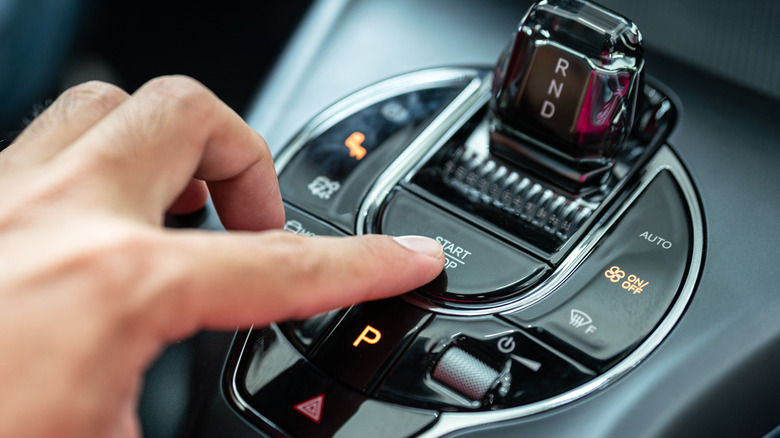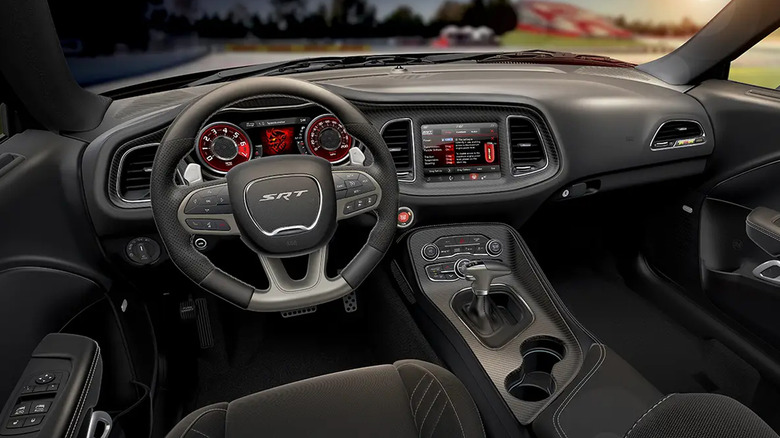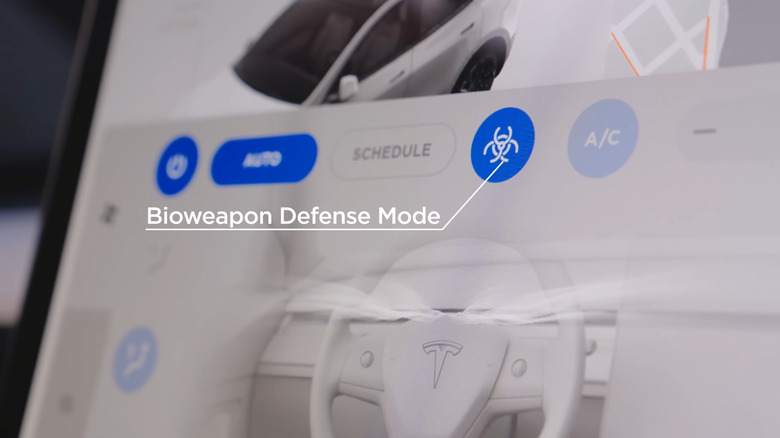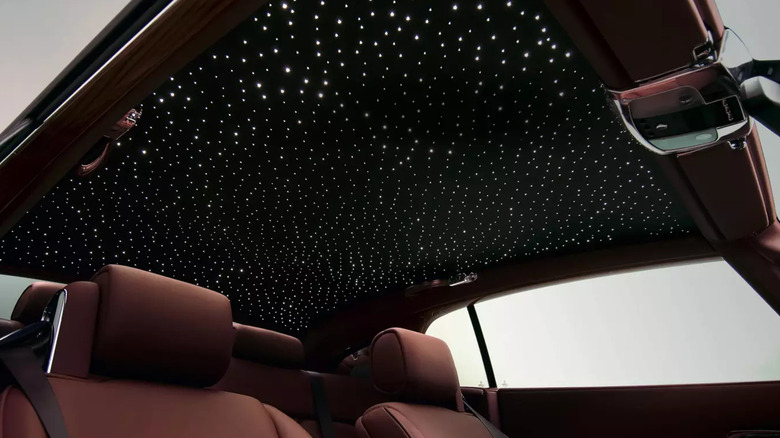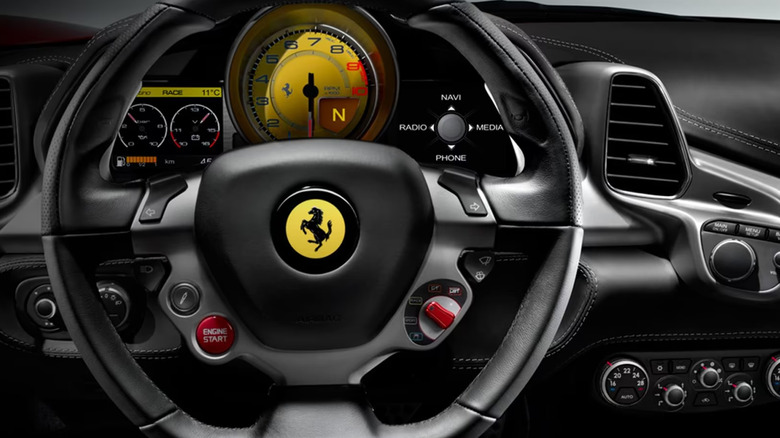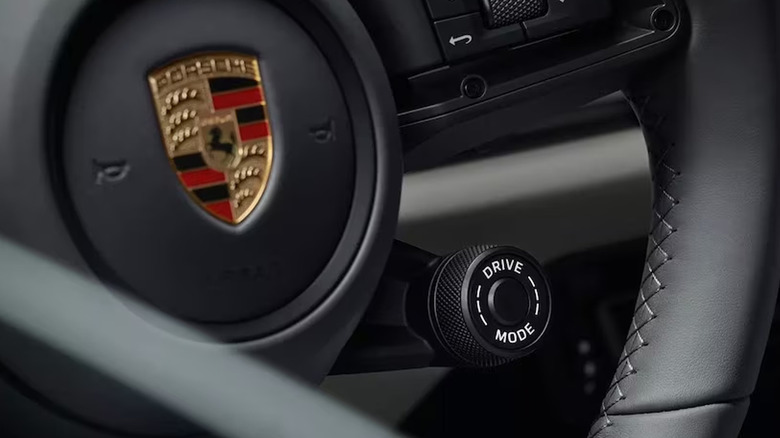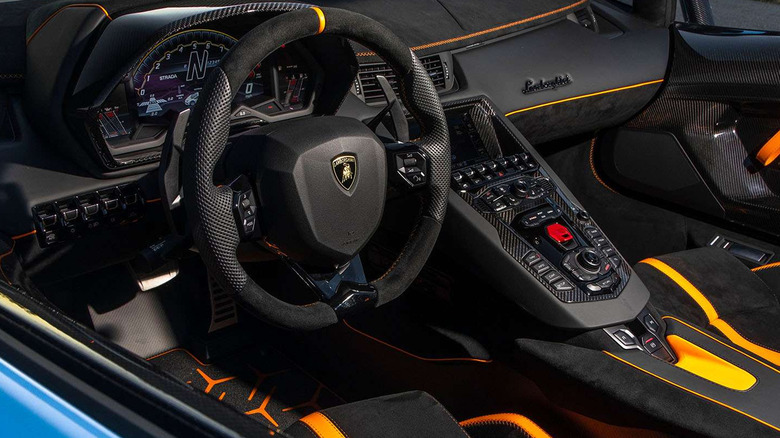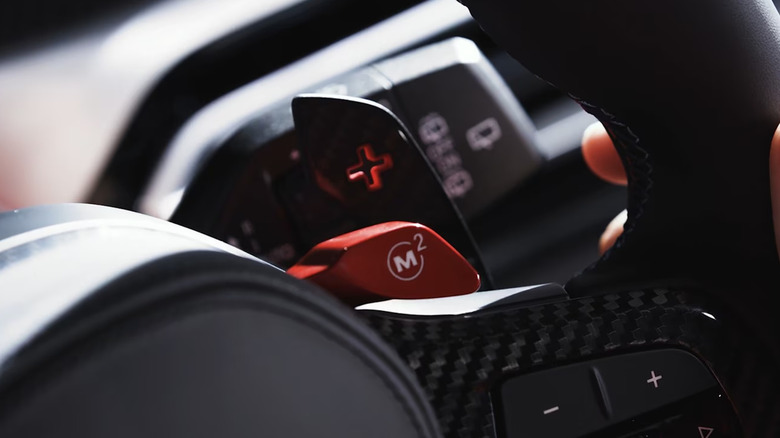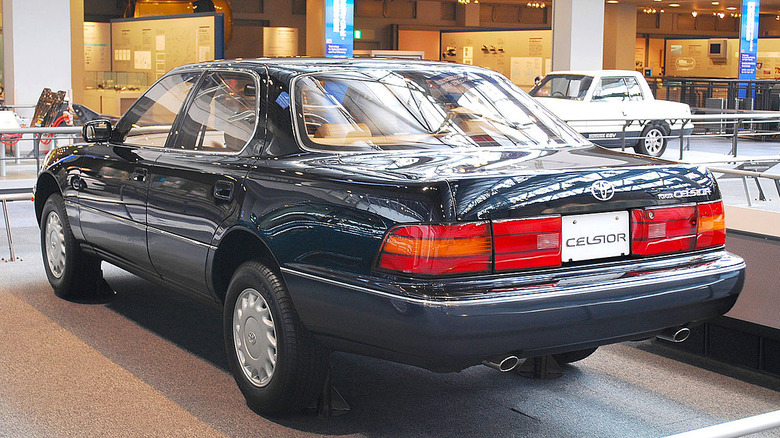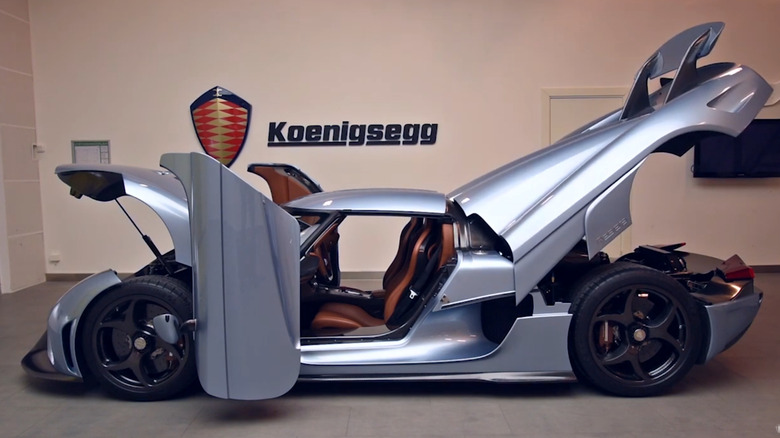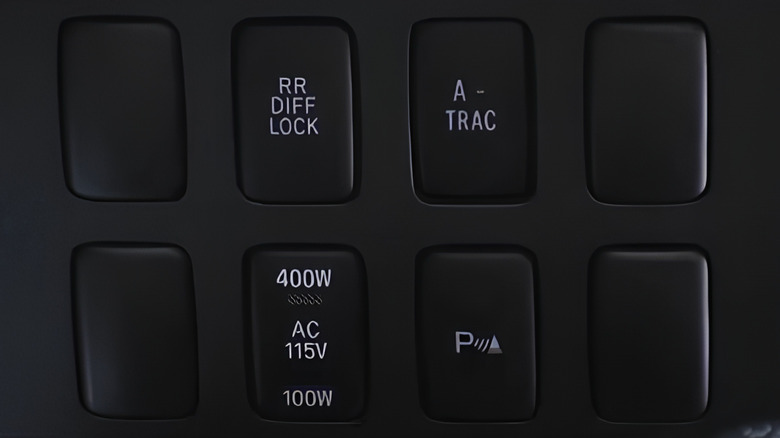10 Of The Coolest Buttons Ever Put Into A Production Car
We may receive a commission on purchases made from links.
Let's be honest. Buttons in modern cars aren't what they used to be. Sure, there are still a few chunky knobs and switches lying around, but in the age of touchscreens and voice controls, many cars are starting to feel more like rolling iPads than mechanical marvels. Most drivers are familiar with the common buttons on cars, such as hazard lights, defoggers, and so on. But what about the uncommon ones? The weird, wonderful, and delightfully over-the-top buttons that do more than just turn something on or off?
We're talking about buttons that tune your car in a flash, create artificial stars inside your car, and even protect you from imaginary bioweapon attacks. Some of them are wildly useful, some are totally absurd, and others sit somewhere in between. But all of them are undeniably cool. Whether it's a clever off-road helper or a hypercar's party trick, these buttons prove that carmakers still know how to have fun. So buckle up and keep those fingers ready as we explore some of the coolest buttons ever put into a production car, each one adding a little drama, magic, or madness to the driving experience.
Dodge Challenger SRT Demon -- Drag Mode Button
In the world of muscle cars, the Dodge Challenger SRT Demon is an absolute legend. But what truly sets it apart from the rest isn't just the power under the hood; It's also the little switch that unlocks its full drag-racing personality, which is the Drag Mode button. Triggered by a press of the SRT button on the center stack near the center console, it activates a preset configuration tailored specifically for the drag strip. Enabling it tweaks the suspension for optimal weight transfer, calibrates the transmission for lightning-fast shifts, adjusts fuel delivery, and even provides advanced steering feel. It's essentially like having a pit crew in your dashboard.
What's even cooler is that it also enables line lock, which holds the front brakes while letting the rear tires spin freely so the driver can do a proper burnout to warm up the tires — all with the push of a button. Dodge engineered this feature to help drivers launch harder and more consistently, making it far more than just a gimmick. While the Demon itself was a limited-production car and no longer in production, this kind of performance-focused one-touch setup has inspired similar drive mode buttons in other Dodge models, including the new Charger Daytona EV. Still, nothing quite matches the thrill of engaging Drag Mode in the original Demon.
Tesla Model S – Bioweapon Defense Mode
Tesla has never been shy about adding wild features to its vehicles, and one of the most eyebrow-raising ones is the Bioweapon Defense Mode. Found in the Model S and other Tesla models equipped with the Premium Upgrades Package, this feature is activated with a dedicated button on the touchscreen interface. Yes, it's not a physical switch, but definitely one that makes an impression. Once activated, it powers up an enormous HEPA filtration system capable of cleaning the air inside the cabin to near-hospital standards.
Tesla claims this system can filter out bacteria, viruses, and harmful gases, even during serious pollution events or hypothetical bioweapon attacks, leading to its over-the-top name. In practice, it's incredibly effective at removing smog, smoke, and allergens, which makes it useful for daily driving in heavily polluted cities. The feature gained real-world attention during California wildfires and other air quality emergencies, and many Tesla owners swear by it. The button remains available in newer Model S and Model X vehicles, and even though it's a touchscreen input rather than a physical button, its utility and drama make it one of the most memorable automotive features in recent years.
Rolls-Royce – Starlight Headliner Control
Luxury is all about the little details, and in a Rolls-Royce, those details often come with their own button. The Starlight Headliner is one of the brand's most iconic features, offering a stunning ceiling filled with hundreds of fiber-optic lights that mimic a starry night sky. With a simple, physical control button located in the overhead console, occupants can turn the display on or off and even adjust its brightness. In some models, the constellations can be custom-ordered to represent the night sky on a specific date or even feature shooting stars for added drama.
It's worth noting that this button does nothing for performance, handling, or fuel efficiency. Then again, that's precisely why it's so cool. It serves no purpose other than delighting passengers and giving them the sense of floating through the galaxy in utter silence. Rolls-Royce still offers this feature on most of its modern lineup, including the Ghost, Phantom, and Spectre. It's a perfect example of over-the-top features on luxury cars. And in true Rolls fashion, the physical feel of the button is buttery smooth, no cheap clicks here.
Ferrari 458 Italia – Manettino Switch
Ferrari has always been about performance and passion, and the Manettino switch is a symbol of that philosophy. Found prominently on the steering wheel of the 458 Italia and other modern Ferraris, this physical rotary dial allows the driver to shift through various driving modes with a flick of the thumb. Each mode adjusts parameters like throttle response, suspension stiffness, traction control, and transmission behavior. The available settings typically include Wet, Sport, Race, Comfort, and Electronic Stability Control Off, escalating from calm daily driving to full-on track-ready aggression.
The Manettino isn't just functional, it's emotional. Flipping that switch feels like unlocking a new version of the car each time. What makes it particularly cool is its race-inspired design and placement. It's basically derived from Formula 1 steering wheels, where everything is within easy reach. To this day, the Manettino switch remains a core part of Ferrari's interface across models, including the 488, F8 Tributo, and even the Purosangue SUV. It's a great example of how a physical control can be both intuitive and exhilarating, giving the driver an instant and tactile connection to the car's character.
Porsche 911 – Sport Response Button
Porsche's Sport Chrono Package includes one of the most thrilling buttons ever put into a road car, which is the Sport Response Button. This physical button sits right in the center of the drive mode dial on the steering wheel and offers something every enthusiast secretly craves: instant power. Press it, and the car primes the turbos, sharpens throttle response, and delivers maximum engine and transmission performance for 20 seconds. Think of it as a virtual NOS boost for your Porsche — a 20-second surge of full-throttle urgency that feels like it was ripped straight out of an arcade racing game.
This feature isn't just a gimmick either. It's designed for real-world situations like overtaking on a two-lane road or finding that perfect exit speed during a hot lap, making it totally worth it. The button is easy to reach without taking your eyes off the road, and its physical click gives a satisfying sense of control in the middle of all that high-tech wizardry. Porsche continues to offer the Sport Response Button on newer 911 models as well as the Panamera, Macan, and even the Taycan in certain configurations. It's proof that a small, well-placed button can deliver serious excitement, with no flashy graphics or touchscreens required.
Lamborghini Aventador SVJ – Fighter Jet-Style Start Button
Lamborghini has never been the brand for subtlety, and the Aventador SVJ is proof of that, right down to the way it starts. Instead of just pressing a basic ignition button, Lamborghini makes you flip open a bright red cover, just like you're about to launch a missile from a fighter jet. Only then can you press the actual start button underneath and fire up that glorious V12. Is it completely unnecessary? Absolutely. But it's also so cool that it practically dares you not to make vroom-vroom noises with your mouth.
This feature is more about drama than function, but that's kind of the point. Starting the car becomes a ritual, and when a 770-horsepower engine roars to life after that extra theatrical step, it feels 10 times more satisfying. Lamborghini has carried this start-up theatrics into newer models like the Huracán Tecnica and Revuelto, but the idea hasn't stayed exclusive. Other carmakers have started copying the look, and you can even find aftermarket flip-up covers on Amazon that stick over the start/stop button of regular cars, turning your Corolla into a budget fighter jet. It's silly, it's dramatic, and it's totally Lamborghini. And honestly, it makes every start-up feel like the beginning of a mission.
BMW M Cars (with M Drive)
For BMW enthusiasts, the M1 and M2 buttons on the steering wheel are small but mighty. These are physical buttons that allow drivers to save custom drive mode configurations and toggle them instantly. You can tailor settings like engine response, suspension stiffness, steering weight, and even transmission shift speed, then assign them to either button for one-tap activation. Think of it as a create-your-own-driving-mood setup.
In practice, this feature turns a high-performance BMW into a dual-personality machine, capable of being comfortable in one moment and track-ready the next. The M Drive system has been around for years and is still found in modern models like the M3, M5, and M8. These buttons have become one of the defining traits of BMW's M cars, offering serious convenience and performance flexibility in an easy-to-use layout. They might not look flashy, but they're the gateway to unlocking everything your M car can do, and that's what makes them cool.
Toyota Celsior – Ultrasonic Mirror Cleaning Button
I bet you didn't expect to see a car from 1989 on this list, did you? Well, here's a button that feels straight out of a sci-fi anime — the ultrasonic mirror cleaning button in the Toyota Celsior. Found in select JDM versions of this luxury sedan (which later evolved into the Lexus LS), this button activates ultrasonic vibrations in the side mirrors to literally shake off water droplets. Yep, no wiping, no heating; Just high-frequency sound waves giving your mirrors a little shimmy to stay clear during rain. It's the kind of engineering quirk only Toyota could pull off with a straight face.
This is a real, physical button that was designed with Japanese precision and backed by legit research. In fact, there's even a technical paper published by SAE International that explains how the system works. If reading papers isn't your thing, you can see the button in action in this Instagram reel. Trust us, it's weirdly satisfying. While the feature never made it to global Lexus models, it remains one of the coolest automotive Easter eggs ever tucked into a production car. In an era where most mirror tech is either heated or hydrophobic, Toyota literally shook things up.
Koenigsegg – Ghost Squadron Button
Press the Ghost Squadron button in a Koenigsegg, and the entire vehicle performs a neat magic trick. The dihedral doors swing open, the front trunk lifts, and the rear clamshell peels back in perfect synchronicity, all without a human hand in sight. It's called Autoskin, and it turns the car into a kinetic sculpture at the push of a very real, very satisfying physical button on the key itself.
But here's the twist: This bit of hypercar theater isn't just for show. The button wears Koenigsegg's iconic ghost logo, which isn't some edgy branding choice. It's a tribute to the Swedish Air Force's Ghost Squadron, whose former airbase now houses Koenigsegg's headquarters. When the squadron retired, Koenigsegg was granted permission to carry on the emblem, which is a fitting symbol for a brand that builds road cars with fighter jet-level engineering.
The Ghost Mode feature is available in models like the Regera, Jesko, and Gemera, and even after watching it a dozen times, it still makes jaws drop. It might not improve lap times, but it turns unlocking your car into a full-blown event. Now that's flexing for the cameras.
Toyota FJ Cruiser – A-TRAC Button
The Toyota FJ Cruiser is beloved by off-road enthusiasts, and part of the reason is its smart traction tech, controlled via the A-TRAC button. This physical button sits near the center console and activates Active Traction Control, which helps the SUV maintain grip even in extremely slippery or uneven conditions. Instead of relying on traditional limited-slip differentials, the system brakes individual wheels to keep power flowing where it's needed most.
The button isn't flashy, but it's incredibly effective and simple to use. Press it once, and the system quietly takes care of maximizing traction without the driver having to think too much. Toyota still uses A-TRAC in some of its off-road-oriented vehicles like the Land Cruiser and 4Runner, though the FJ Cruiser remains the poster child for this clever bit of engineering. In a world where many off-road features are buried in submenus or apps, having a dedicated button that actually makes a difference earns the A-TRAC button a well-deserved spot on this list.
